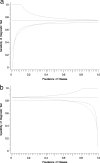Utility of composite reference standards and latent class analysis in evaluating the clinical accuracy of diagnostic tests for pertussis
- PMID: 17989336
- PMCID: PMC2223853
- DOI: 10.1128/CVI.00223-07
Utility of composite reference standards and latent class analysis in evaluating the clinical accuracy of diagnostic tests for pertussis
Abstract
Numerous evaluations of the clinical sensitivity and specificity of PCR and serologic assays for Bordetella pertussis have been hampered by the low sensitivity of culture, the gold standard test, which leads to biased accuracy estimates. The bias can be reduced by using statistical approaches such as the composite reference standard (CRS) (e.g., positive if culture or serology positive; negative otherwise) or latent class analysis (LCA), an internal reference standard based on a statistical model. We illustrated the benefits of the CRS and LCA approaches by reanalyzing data from a 1995 to 1996 study of cough illness among 212 patients. The accuracy of PCR in this study was evaluated using three reference standards: culture, CRS, and LCA. Using specimens obtained 0 to 34 days after cough onset, estimates of the sensitivity of PCR obtained using CRS (47%) and LCA (34%) were lower than the culture-based estimate (62%). The CRS and LCA approaches, which utilized more than one diagnostic marker of pertussis, likely produced more accurate reference standards than culture alone. In general, the CRS approach is simple, with a well-defined disease status. LCA requires statistical modeling but incorporates more indicators of disease than CRS. When three or more indicators of pertussis are available, these approaches should be used in evaluations of pertussis diagnostic tests.
Figures



References
-
- Alonzo, T. A., and M. S. Pepe. 1999. Using a combination of reference tests to assess the accuracy of a new diagnostic test. Stat. Med. 18:2987-3003. - PubMed
-
- Alvord, W. G., J. E. Drummond, L. O. Arthur, R. J. Biggar, J. J. Goedert, P. H. Levine, E. L. Murphy, S. H. Weiss, and W. A. Blattner. 1988. A method for predicting individual HIV infection status in the absence of clinical information. AIDS Res. Hum. Retrovir. 4:295-304. - PubMed
-
- Bartholomew, D. J., and M. Knott (ed.). 1999. Latent class models, p. 133-156. In Latent variable models and factor analysis, 2nd ed. Oxford University Press, New York, NY.
-
- Baughman, A. L., K. M. Bisgard, K. M. Edwards, D. Guris, M. D. Decker, K. Holland, B. D. Meade, and F. Lynn. 2004. Establishment of diagnostic cutoff points for levels of serum antibodies to pertussis toxin, filamentous hemagglutinin, and fimbriae in adolescents and adults in the United States. Clin. Diagn. Lab. Immunol. 11:1045-1053. - PMC - PubMed
-
- Bedrick, E. J. 1998. Biserial correlation, p. 404-407. In P. Armitage and T. Colton (ed.), Encyclopedia of biostatistics, vol. 1. John Wiley & Sons, Inc., New York, NY.
MeSH terms
LinkOut - more resources
Full Text Sources
Medical
Research Materials

